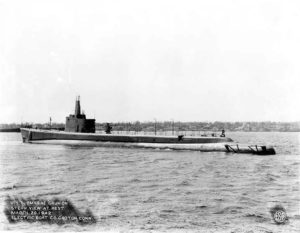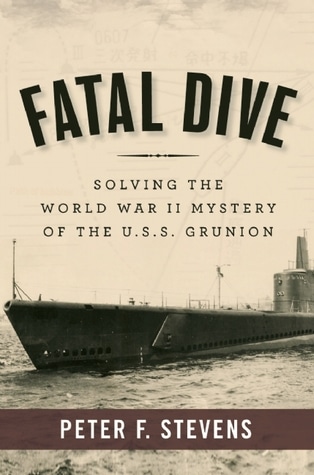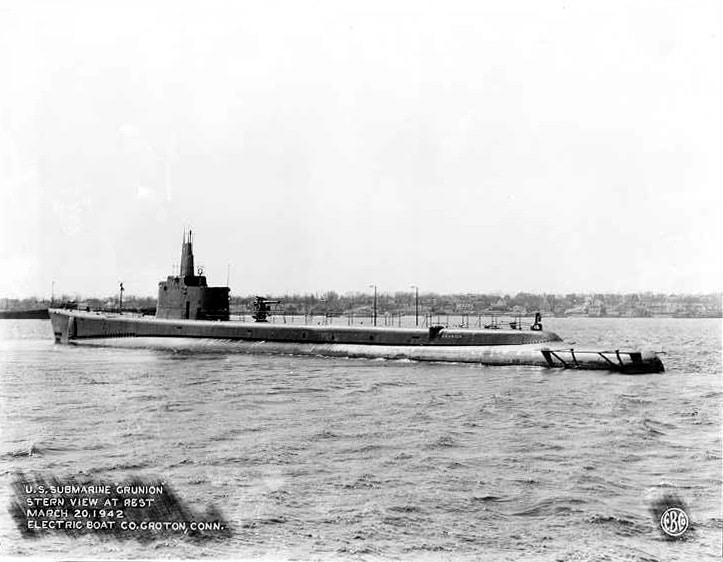Mandeville, LA – Exclusive Transcript – In July, the last day of July 1942, the Grunion was the only American sub operating off this spot in the Aleutian Islands, Kiska Island. She hadn’t received the message apparently to come back to base like the other American submarines had, because there was a heavy bombardment campaign going on up there and they wanted to get her out of the water. She had an encounter, a battle with an armed Japanese cargo ship, a large one. The Grunion crippled her with one of the Grunion’s torpedoes. A bunch of other things happened during the fight. The Japanese claimed that they had sunk the American submarine the Grunion with their deck gun, a three-inch deck gun. Check out today’s transcript for more…
Begin Mike Church Show Transcript
Mike: The book is called Fatal Dive: Solving the World War II Mystery of the USS Grunion. This is a really easy, soft read. In other words, it’s easy to read. The pages flow almost like a mystery novel, but it’s a true story. If you like a good whodunit and if you like a good documentary on some mystery that was never solved by history, this is for you. We have the author of the book, Peter Stevens, on the Dude Maker Hotline right now. Mr. Stevens, it’s good to have you with us. Thank you very much for being on the program today. How are you, sir?
Peter Stevens: I’m doing fine, thank you. It’s great to be on.
Mike: I have to ask, first of all, what attracted you to the story of the USS Grunion? I gotta confess, I’m a history buff and I had never heard this story before.
Peter: There were a couple of things that attracted me. As you mention, the historical mystery aspect of it, it’s something that always draws me and it’s been a big part of my own work. Around here, the story got a lot of play both on TV and radio. People were caught up in this whole idea of these three elderly brothers going after and finding a submarine that actually their father commanded in World War II. It disappeared without a trace on July 30th, 1942 up in Alaska off the Aleutian Islands. It hadn’t been solved. Basically these guys just wanted to find out what had happened to their father and his crew. That’s how it started out. Also, to try to do that and bring some sense of closure, if there is such a thing as closure, to the 69 other families of the crew.
Mike: You’re talking about Bruce, Brad and John Abele. As I was reading the book and as I was looking at the photographs as you began to discover where the Grunion was, one of the pictures that is really intriguing is the one where your footnote is “A very difficult to read sonar image of the Grunion.” Was that the first instance in 2006 that they thought they were onto it?
Peter: It really was. It was quite a big deal just to get equipment up there, the sonar equipment and later a remote-operated vehicle like the one that found the Titanic. These waters, if anyone has ever seen the show Deadliest Catch about the Alaskan fishermen up there, these waters are just horrific, the wind, the waves, all of it. It’s just unbelievable. There’s only a couple weeks in August where you can even make the attempt because of the weather, to get the equipment out into these waters. That’s what they did. Those sonar images they got, it’s hard, when you look at those, to determine one way or another what something might be. They felt they had it because those images came up from the spot where they believed the sub had gone down, where the Japanese said the American sub had gone down. The Abeles really had the feeling that they had it.
The sonar team they sent out were 95 percent certain, as they put it, but a lot of the experts including Robert Ballard, the guy who found the Titanic, and he had basically coached, helped the Abeles put this together. He couldn’t go himself because he was committed to another expedition. He was very, if not skeptical, very guarded about it. He felt that it could be a surface ship. There were things to him that just didn’t look consistent with a submarine lying down there. Mind you, this thing was 3,000 feet down. It’s not like you could send a diver down there with a camera to take pictures of it. Ballard cautioned that they shouldn’t be fooled into thinking this is what they wanted it to be. The Abeles, undaunted, the next summer, they went out with an ROV. This time, by a bunch of incredible circumstances, locked all of it. This is really a needle-in-a-haystack kind of search. This time they got visual images of the Grunion so there was no doubt that the submarine lying on a volcanic outcrop 3,000 feet down was in fact their father’s sub that had gone down 65 years earlier.
Mike: Peter Stevens, author of Fatal Dive: Solving the World War II Mystery of the Grunion on the Dude Maker Hotline with us. If you would, Mr. Stevens, could you just walk the audience briefly through how the Grunion actually went down and what they told the Abele family when the news was broken in the 1940’s?
Peter: In July, the last day of July 1942, the Grunion was the only American sub operating off this spot in the Aleutian Islands, Kiska Island. She hadn’t received the message apparently to come back to base like the other American submarines had, because there was a heavy bombardment campaign going on up there and they wanted to get her out of the water. She had an encounter, a battle with an armed Japanese cargo ship, a large one. The Grunion crippled her with one of the Grunion’s torpedoes. A bunch of other things happened during the fight. The Japanese claimed that they had sunk the American submarine the Grunion with their deck gun, a three-inch deck gun.
What happened was that didn’t wash with a lot of experts. The shell from that gun, they just didn’t feel it could have penetrated the Grunion’s thick, steel skin below the waterline. There was no question that the sub had sunk and the Japanese naturally thought they had it. When they began to assess the video that they have and the stills, a lot of people began to see a few things, the way the damage to the sub was. It turns out that the most plausible scenario for the Grunion’s loss was one of the Grunion’s own torpedoes. It was an experimental torpedo called the MK14.
The Navy had a lot of problems with this torpedo. It wasn’t performing the way it should and it had a number of serious flaws, including one in that sometimes the sub would dip under the target or just miss the target and turn around, make a circle, what was called a circular run, and come back to the point of origin, the sub that had fired it. That, apparently, is what happened to the Grunion. She had this Japanese freighter crippled and the torpedo came back on her and hit her at the very base of the conning tower. Those things are like fins that stick out. It set off a chain reaction of things that the Grunion couldn’t recover from. She went into a hard dive. Jim Abele, the commander, would have put her into that the moment they heard this torpedo coming in, but unfortunately it hit. One thing that is absolutely certain, the dive planes that control the angle of the dive on a submarine, they were jammed into the most severe position, a hard dive. They jammed on the Grunion and there was no way that the crew could pull her up to that dive, so she was sent to the bottom.
The bottom line was the performance of the torpedoes did doom the Grunion, her own torpedoes. The Navy actually didn’t know, in July of 1942, what had happened to the Grunion. She did disappear without a trace. The Japanese had written a number of eyewitness accounts, battle reports. They had a chart of the position. One of the charts had a bubble trail marked on it going back to the submarine, which would have been the torpedo. The Japanese accounts of it give a very vivid description of bubble trails going right back to the Grunion. A lot of things began to add up that way.
It was all part of what was called the Great Torpedo Scandal of 1941 to 1943 in which the admirals in charge of the submarine fleet and the contractors that made these torpedoes, they reacted way too slowly. They ignored the skippers’ concerns. Before the Grunion went out, there were other skippers coming back with these reports of how poorly the torpedo was performing, wasn’t doing anything it was supposed to do. They were having a terrible time, begging for help. Their pleads were ignored until 1943 when an admiral named Charles Lockwood became commander of the sub fleet. He had gone out on patrol with these torpedoes and saw. He finally took care of the issue.
Mike: I guess that’s the conspiracy part of the whole story, that someone should have intervened to stop that particular torpedo from being used and they didn’t. That’s what the surviving families — 72 crew members?
Peter: There were 70 in all, including Abele.
Mike: Seventy crew members all went down on this submarine. It’s a great story that you’ve woven together here. When’s the movie coming out?
Peter: I don’t know. It’s certainly dramatic. The thing of it is, no matter what, to me, it’s an apolitical story in that it’s about patriotism, family, love. This family, these three brothers, their mom had tried for decades to get answers to what might have happened. The sons picked up the mantle. Obviously they were young when their dad disappeared. They were 12, 9 and 5. They had the wherewithal to do it. John Abele was enormously successful. He’s the founder of a company called Boston Scientific, which is a huge medical company globally. He had the means to do it. Again, the odds on this were a million to one. They were willing to do that, the brothers, to try to get some answers for themselves and for the other families. I think it’s a remarkable thing. Another remarkable aspect of it was that the clues that allowed them to even put an expedition together, to go to Robert Ballard and even talk about this, they came from the Japanese. They came from Japanese naval records and a Japanese fellow named Usagi who helped them. Without those things, they never could have mounted a search. The Grunion’s whereabouts would still be a mystery and what happened to her would still be a mystery.
Mike: This Shinoda woman you have a photograph of in the book, was she an eyewitness to this? What’s her role?
Peter: No. What happened was this family, the Abeles, developed a connection with the Shinoda family. It’s kind of a sad story. She was the widow of a sub chaser that the Grunion sank off the Aleutian Islands. The Grunion sank two sub chasers off the Kiska harbor. Her husband commanded one of those. He was killed and went down with his ship, and all hands lost with that. As the clues began to come from Japan, the Abeles began to develop relationships with some of the families over there. They became very close to the Shinoda family. It’s one of those things with a lot of similarities: same number of kids, everybody was relatively the same age when they both lost their fathers and husbands. There were just all these similarities and connections that bonded the family. The Abeles, when they mounted the expedition up there, they we relooking for the Grunion, but they also were looking to try to find the two subchasers, see where they had gone down, maybe bring some sort of closure to the Japanese families.
I know the Abeles felt this connection that these Japanese families who were caught up in the same thing that the Abele family and the 69 other families of the Grunion were caught up in. In a sense, it’s been so long, they were all patriots. They all loved their own country. They were fighting for their own country. In the end, like today, you have families caught up in this. I think there’s a bond that can develop between people. As Bruce Abele said, it gives him some sort of hope that maybe people will get along better someday and a lot of these enmities will end. You do see that these kinds of circumstances can draw people who were once antagonists together.
End Mike Church Show Transcript
















John in MD on August 11, 2012
Great interview Mike, appreciate you posting the article as I am usually unable to listen to your show. The USS Tang SS-306 sank herself in the Formosa Strait in 1944 when one of her torpedoes did a circular run on her.(I recommend to you the book “Clear the Bridge!” as a review of her war cruises) Now here is the story of the USS Grunion, who knows how many other submariners went down in WW2 as a result of government ineptitude and negligence producing a weapon that was probably more of a danger to the user than the intended recipient. And to think these incidents happened in a time of war when we had a legitimate enemy to fight and destroy. One would think we would have learned from these incidents that cost so many American lives, but sadly it appears we have not. And the masses want to trust government with our health care? Madness!